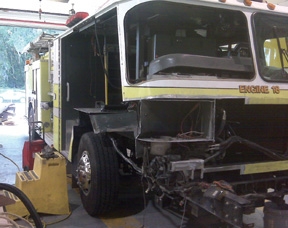 |
| The Little Rock Fire Department chose this E-ONE 100-foot straight stick rear-mount aerial. |
 |
| A Crimson Fire mid-mount 100-foot aerial platform uses two monitors to battle an industrial fire. |
When it comes to purchasing an aerial device, one of the major questions firefighters confront is whether to go with a platform or a straight stick.
Aerial manufacturers say fire departments are buying more ladders than platforms, likely for a number of reasons, but cost is cited as the chief one. In making a choice between the two types of aerials, purchasing committees consider maneuverability, station space, the department’s history, the primary intended use, water flow and safety.
Related to the straight stick versus platform question is another important consideration — mid-mount or rear-mount. Some of the same factors must be taken into account, as well as travel height, compartment space and on-scene placement of the apparatus.
Statistics compiled by the Fire Apparatus Manufacturers’ Association (FAMA) show that 50 percent more ladders than platforms were purchased in 2009 in the United States (249 ladders and 163 platforms). The data also show that three times the number of rear-mount aerials were purchased that year compared to mid-mounts.
Joe Hedges, product manager of aerials for E-ONE, believes budgetary considerations are the chief reason that many departments gravitate toward an aerial ladder instead of a platform.
“It’s an issue many departments face,” he said. “But the cost of a platform could be $100,000 or more than that of a ladder.”
In weighing the platform-versus-ladder question, he said fire officials have to consider the physical space where they plan to store the aerial, as well as maneuverability. Typically, an aerial platform rig is about four to five feet longer than the same length aerial ladder truck.
Jim Salmi, CEO of Crimson Fire, noted that aerial platforms are generally heavier in overall weight than aerial ladders and must also be designed to carry a heavier load at the tip.
“The [National Fire Protection Association] 1901 standard describes the structural safety factors for both ladders and platforms,” Salmi said. “The minimum a ladder can be rated for is 250 pounds (at the tip) and for a platform, 750 pounds.”
The entire aerial structure of a platform is heavier and deeper in cross section, making it more robust. Ladder sections of platform aerials are typically deeper to accommodate greater stress, and the gross vehicle weight also is generally greater.
“Typically, a 100-foot ladder truck with no pump or tank will weigh between 55,000 and 60,000 pounds,” Salmi said. “A platform runs about 10,000 pounds more.”
He said he has seen many cities go with straight sticks instead of platforms. “A lot of their concerns are related to the speed of operation and working in tighter areas,” he said. “But, often major cities will have a mix of several ladders and a couple of platforms.”
With a platform, firefighters don’t have to climb the aerial and be exposed to fire ground elements, Salmi pointed out. In addition, platforms have a higher capacity at the tip and offer a safer working environment, as well as large capacity of water flows.
Bryan Smeal, regional sales director of Smeal Fire Apparatus Co., said many fire officials who switch to platforms after running ladders for a long time often are thinking of the rescue capability a platform affords.
“It’s a lot easier for getting people out of a building because they can step into the platform instead of climbing onto an aerial ladder,” Smeal said. “That’s the biggest reason.”
Smeal said his firm sold an equal number of ladders and platforms last year, although in previous years the split was about two-thirds ladders to one-third platforms.
“We do see a trend,” he said. “When a department buys a 100-foot platform, it’s not as tricked out with options as it might have been in the past.”
Paul Christiansen, marketing director for Ferrara Fire Apparatus, said the advantage of riding to the roof on a platform instead of climbing an aerial ladder is why platforms are so popular with firefighters.
Ferrara makes an aerial platform with extra-wide openings that allow firefighters to bring a rescue chair through. The platforms also are fitted with rappelling arms and rescue basket brackets to allow high angle rescues to be performed.
Hedges agreed that most firefighters would prefer to ride a platform to the roof, and that it provides a much better work station.
“They can have more equipment at their disposal, including hand tools and additional hose lines,” he said. “And it’s better to put a rescue basket in the platform and bring it down that way instead of sliding it down the rungs of a ladder. For transporting people who can’t climb, like the elderly or small children, the platform is a big plus.”
On the flip side of the question, though, he pointed out that aerial platforms, because of their size, can be more difficult than ladders to thread into certain targets.
“A benefit of a ladder is it’s easier to spot the tip of the aerial,” Hedges said. “The ladder also is able to provide a continuous stream of access to a roof or elevated place.”
Another ladder truck benefit, he said, is that they are easier to get in and out of tight spots because they’re a bit shorter and more maneuverable than platform aerials.
Donley Frederickson, national sales manager for Rosenbauer, pointed out that aerial platform waterway flow configurations can be increased because they are generally built heavier than ladders.
“We’ve done up to 3,000 gpm flow on a platform, although structurally we had to change the base, mid and fly sections of the aerial to make it stronger,” he said.
Platforms usually can dip lower than ladders, Frederickson noted, with a 100-foot rear-mount platform running minus 12 degrees depression to plus 75 degrees elevation, compared to minus 10 degrees and plus 75 degrees for a 100-foot ladder. Often those two degrees make a difference when working a below grade rescue, he said.
And, Frederickson pointed out, platforms tend to be more stable because they are built on three section aerials, compared to four or five sections for ladders.
Tim Smits, national sales manager for Pierce Manufacturing Inc., touts the versatility of ladders when working in tight or congested areas.
“They’re easier to position because the tip of the aerial is smaller than a platform,” he said. “So if there are a lot of trees or power lines around, the aerial is easier to maneuver to the target, and if you’re doing a rescue, you can pin the waterway back and put the tip into a window.”
On the other hand, Smits cited the higher water flow capability of platforms, especially using dual monitors. “Where ladders might flow 1,500 gpm,” he said, “a platform can flow 2,000 gpm, meaning you can have that second monitor.”
Salmi agreed with Smits’ assessment on the water flow capability of platforms. “It’s a more robust structure that lends itself to dual monitors for two master streams,” Salmi said. “Very often the fire ground commander will have one master stream on the fire and another on an exposure. But with a ladder, you don’t have space up there for two monitors because the monitor is in line with the ladder.”
In terms of control systems, Salmi said ladders are much simpler, with most controlled by hydraulic valves. Virtually every platform has electronic controls, he said.
While ladders have been a mainstay of the fire service for decades, Salmi said a platform will do everything a ladder will do – and more. “It’s a safer environment for everyone, there’s breathing gear on a platform, 110-volt lighting and other enhanced capabilities,” he said. “Plus, you don’t have to climb.”
On the question of mid-mount versus rear-mount aerials, Smits said more departments buy rear-mounts than mid-mounts.
“Generally, we can give them more compartmentation on a rear-mount aerial,” he said, “and the pump compartment is more accessible instead of being pushed down on a mid-mount. Plus, there are more pump options available on a rear-mount, and foam and CAFS are easier to package because there’s more room.”
In addition, Smits said, since rear mounts are heavier, manufacturers can put larger water tanks on them. They also have greater reach and sweep capabilities because they can work off the back and 180 degrees on each side. With a mid-mount, the aerial operator has to deal with the cab much closer to the pedestal and has the body of the truck in the way when working directly to the rear.
In terms of handling, Crimson’s Salmi pointed out a rear-mount can get to the ground in more positions than a mid-mount.
Smeal sees the main advantage to a mid-mount as its lower travel height.
“A rear-mount will typically be in the 12-foot range, while mid-mounts can be run between 10 feet and 11-1/2-feet in overall travel heights,” Smeal said. “Choosing a type may depend on the run area of a fire department, if it has a lot of low bridges or overpasses, or if it has older stations with lower doors.”
Christiansen pointed out that some metropolitan departments purchase mostly rear-mount apparatus, but choose a mid-mount if they have a low station height in one area. Ferrara’s standard mid-mount height is 10 feet, 9 inches, while its standard rear-mount height is 12 feet, 2 inches.
Hedges said E-ONE, as is the case with most other manufacturers, sells more rear-mount apparatus than mid-mounts.
If a department has height considerations in its district, the mid-mount might be the answer, he noted, but because the body is lower to the ground and somewhat shorter than a platform, it means less compartmentation.
“All things are fighting for space to fit under an aerial device,” he said, “and with a mid-mount, those have to be compromised.”
While rear-mounts have less overhang at the back than mid-mounts, a disadvantage is that the platform hangs over the front of the truck and can affect the driver’s visibility in some quadrants. E-ONE offers a switch to pivot a rear mount platform up 10 degrees to gain more visibility.
But mid-mounts suffer from the difficulty of having a platform hanging off the rear of the vehicle, which can pose problems when negotiating the transition to a steep grade and when making tight turns.
Hedges noted that many firefighters consider rear-mounts more difficult to spot at a fire scene, especially if a pumper is first due. The aerial’s turntable might be 40 or 50 feet farther back than optimal, making it more difficult to hit a target. With a mid-mount, there’s a better chance in that situation of getting the turntable closer to the fire building.
In the end, Christiansen said choosing a ladder or platform comes down to one main consideration.
“Ladder verses platform is an operational issue for any fire department,” he said. “It’s what works best for their town and how they plan to use it.”
More Fire Apparatus Current Issue Articles
More Fire Apparatus Archives Issue Articles

